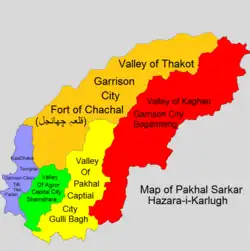Sultanate of Hazara
The Sultanate of Hazara or Hazara Sultanate also natively known as Hazara i Karlugh was an early modern empire based in South Asia between the 15th and 18th centuries. The sultanate encompassed the modern Hazara region, bordering Kashmir Subah to the east, Lahore Subah to the south, Kabul Subah to the west and the semi autonomous states of Gilgit to the north. The Karlugh Turks ruled the region autonomously under the Timurids until 1480, establishing their sovereignty.[1]
Hazara Sultanate Persian: سلطنت ہزارہ | |||||||||
|---|---|---|---|---|---|---|---|---|---|
| 1480–1713 | |||||||||
 Sultanate of Hazara and its sub-divisions | |||||||||
| Status | Independent (1480–1526) vassal state of Mughal Empire (1526–1713) | ||||||||
| Capital | Guli Bagh | ||||||||
| Common languages | Persian (official and court language) Hindko (tribal language) | ||||||||
| Religion | State religion Sunni Islam Others Hinduism Sikhism | ||||||||
| Demonym(s) | Karlughs Hindkowans | ||||||||
| Government | Monarchy | ||||||||
| Sultan | |||||||||
• 1480–1526 | Babur Mirza (first) | ||||||||
• 1654–1713 | Mehmud Khurd (last) | ||||||||
| Historical era | Early Modern Period | ||||||||
| 1399 | |||||||||
• Sultanate proclaimed | 1480 | ||||||||
• Conquered by Swatis | 1713 | ||||||||
| Currency | Dinar | ||||||||
| |||||||||
| Today part of | Pakistan Afghanistan | ||||||||
Mughal Hazara (Pakhli) was established as a Sarkar of the Lahore Subah in 1526 in the Mughal documents. It was not until the conquest of Kashmir in 1586 that Hazara/Pakhli was demoted to a Parganah under the newly established Kashmir Sarkar of the Kabul Subah and was often called Hazara/Pakhli Parganah but in 1638 with the raise of status of the Kashmir Sarkar to Kashmir Subah, Hazara was also raised to a Sarkar hence the name Hazara/Pakhli Sarkar.[2][3] The Ain-i-Akbari refers to this entire region as Sarkar Pakhli.[4]
References
- Khan, Shakirullah. "Guli Bagh the last capital of Pakhli, Khyber Pukhtunkhwa, Pakistan".
{{cite journal}}: Cite journal requires|journal=(help) - Zutshi, Chitralekha (2019-09-11). Kashmir. Oxford University Press. p. 30. ISBN 978-0-19-099046-6.
- Siyar-ul-Mutakherin
- Abu'l-Fazl, 16-17th century. tr. H.S. Jarrett, v 2, p 397 (1891)